 For years now, the prevailing wisdom in self-publishing has been that periodically pricing a book at free for a few days is a great way to build an audience. More recently, many authors are reporting that giving away thousands of free copies of a book has almost no ongoing positive impact on sales. Which view reflects reality?
For years now, the prevailing wisdom in self-publishing has been that periodically pricing a book at free for a few days is a great way to build an audience. More recently, many authors are reporting that giving away thousands of free copies of a book has almost no ongoing positive impact on sales. Which view reflects reality?
The evolving consensus seems to be that while massive giveaways worked well in the past, they don’t work now. Multiple authors have reported that their giveaways have resulted in few, if any, reviews, and also that it was difficult to ascribe many (and sometimes any) downstream sales as a result of their free promotions.
Promotional Blast vs. Permafree
On the other hand many writers (and often the same ones) are reporting good success from repricing a book, usually the first one in a series, to free on an ongoing basis (or on “permafree,” as it’s come to be called). The value they see is that a reader will find that they like what they’ve read, and will then go on to purchase additional copies in the same series.
On its face, this seems to be a contradictory statement – a book that is offered free under one type of promotion produces results, but does not when it is offered for free under another. Can this make sense, and if so, why?
The reason can likely be found in the very different circumstances under which the free copy makes its way onto the reader’s preferred reading device, so let’s take those processes apart and see how they differ.
In the free mass download example, the author will typically sign up several services that send out daily emails – often to more than 100,000 subscribers – offering several free and/or discounted eBooks, or perhaps several in each of multiple genres. While authors can sign up with some of these services without charge, most require a payment which can vary from $15 to several hundred dollars for one day’s inclusion in a daily email (you can find out more about free promotions in my last blog entry).
While some of these services produce modest numbers of downloads, others can produce thousands (at the top of the heap is BookBub, where an author may be rewarded with 8,000 or more downloads). The problem is that the readers that subscribe to these services are exposed to new books every day, 365 days of the year. Downloading a book can be done on a whim, so there’s nothing to prevent a subscriber from subscribing to several of the many services and downloading a book – or even multiple books – every day. If they don’t get around to reading your book by the time their Kindle or iPad starts pleading for mercy, it will likely get deleted with dozens of other unread books to make way for the new treats that are listed in that day’s email.
A reader that stumbles on a permafree book, however, will like do so as a result of visiting your website, receiving a recommendation from a friend, or in some other fashion that exposes them to one book at a time. When they do, there’s a better than even chance that they’re not a subscriber to any of the free downloads newsletters, too. So the chance that they’re already drowning in un-read self-published books is much lower.
So if all of the above is true, should you try the mass download route at all? Good question. I decided to give it a try to find out, and here are the preliminary results.
Goals
As with any other trial, its important to know what your goals are before designing your experiment. For this trial, I focused on two strategies. The first was seeking a hight enough ranking in the Kindle Free list to attract attention from readers who were not members of the subscription services I chose. The second was to get enough books into the hands or readers that enough would actually read it to start a domino effect of reviews and word of mouth referrals.
Trial Methodology and Near-Term Results
I began the trial by placing my second book, The Lafayette Campaign (normally for sale at $2.99) on free for a few days and promoting it solely through social media. The immediate results looked like this:
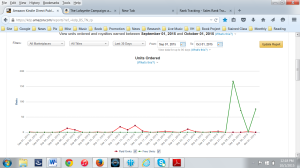 On day one, there were 167 downloads, about 40 of which appeared almost immediately, presumably as a result of the book initially appearing on the free list. On day two, 72 copies were downloaded (that’s the green line; the red line shows the low paid sales in the preceding weeks). I then set the price to $0.99 for one day, and there was no meaningful change to the prior rate of sales or borrowed reads (2 sales, and 93 page reads).
On day one, there were 167 downloads, about 40 of which appeared almost immediately, presumably as a result of the book initially appearing on the free list. On day two, 72 copies were downloaded (that’s the green line; the red line shows the low paid sales in the preceding weeks). I then set the price to $0.99 for one day, and there was no meaningful change to the prior rate of sales or borrowed reads (2 sales, and 93 page reads).
I then set the price back to zero, and launched free promotions with four of the better promotion services (Books Butterfly and Booksends on day one; EReader News Today and FreeBooksy on day two). Here are the results (note that the scale of the chart has changed significantly; that little rise to the left of the spike represents the first days of the trial):
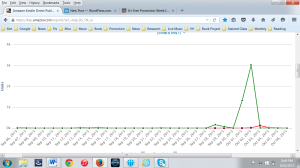 On day one, there were 1,331 downloads, and on day two, there were 3,029, for a total of 4,360 (some of the day two downloads should be attributed to the day one promotions). That’s quite a few books, so if even five percent of those readers actually read the book, that would be 220 people, most of whom would be reading one of my books for the first time. That’s likely not enough to start any type of chain reaction, but at least an author might get a review or two out of the exercise. On the other hand, if the number of actual readers was one per cent, that would be only 44 – far too few to be likely to have type of impact whatsoever.
On day one, there were 1,331 downloads, and on day two, there were 3,029, for a total of 4,360 (some of the day two downloads should be attributed to the day one promotions). That’s quite a few books, so if even five percent of those readers actually read the book, that would be 220 people, most of whom would be reading one of my books for the first time. That’s likely not enough to start any type of chain reaction, but at least an author might get a review or two out of the exercise. On the other hand, if the number of actual readers was one per cent, that would be only 44 – far too few to be likely to have type of impact whatsoever.
So what happened when I reset the price to paid? Crucially, I converted to paid after only two days on free, and when I did, I raised the price to only $0.99. That meant that anyone who was slow to open their email would have to pay for it. Hopefully, it would also mean that they will be slightly more likely to read it as well.
Here’s the result, this time showing only paid sales for the last month:
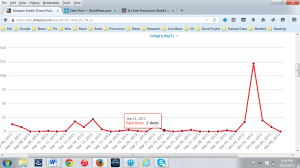 The bumps on the left are previous paid promotions I ran where the price was discounted from $2.99 to $0.99. The results of those promotions were modest, averaging 26 paid sale copies per promotion. The free promotion is farther to the right, and the first step up on this spike is 17 paid sales, occurring in the hour or so before midnight on the second sale day when the repricing took effect in some markets. The next day there were 122 sales and on the second day following the free promotion there were 20. I ran a $0.99 discount sale on day three, and only 8 sales resulted. The next day there were 3, and the following day none. So within as little as two days, the immediate follow-on effect of the free promotion was already over.
The bumps on the left are previous paid promotions I ran where the price was discounted from $2.99 to $0.99. The results of those promotions were modest, averaging 26 paid sale copies per promotion. The free promotion is farther to the right, and the first step up on this spike is 17 paid sales, occurring in the hour or so before midnight on the second sale day when the repricing took effect in some markets. The next day there were 122 sales and on the second day following the free promotion there were 20. I ran a $0.99 discount sale on day three, and only 8 sales resulted. The next day there were 3, and the following day none. So within as little as two days, the immediate follow-on effect of the free promotion was already over.
The results on the page reads side look like this:
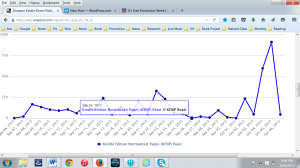 There’s a clear impact on the second and third days following the free promotion, but none at all on day three.
There’s a clear impact on the second and third days following the free promotion, but none at all on day three.
So what are we to make of the results that I’ve seen to date? And what did it cost to run this trial?
Results vs. Goals
I had mixed results with respect to my first goal. My book hit a high point of #51 on the free list, and #1 on both of its sub-categories (Political and Technothriller). While it’s possible this was high enough to make the book noticed by some chart scanners, it’s impossible to tell from the results. Here’s the rate of increase in my rankings during the second day of my promotion, with the overall free rank rising from 120 to 58):
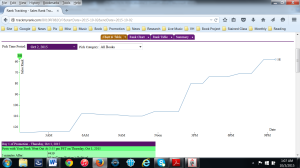 As you can see, running promotions is something like firing the stages on a rocket. Each boosts the effort to a higher level, but after the last stage fires, the promotion reaches its apogee, and then begins to coast down. Worse, after you book returns to paid, you drop off the free list entirely, and reenter the paid list at a rank that can be lower than you were before (because there were no paid sales during the free promotion).
As you can see, running promotions is something like firing the stages on a rocket. Each boosts the effort to a higher level, but after the last stage fires, the promotion reaches its apogee, and then begins to coast down. Worse, after you book returns to paid, you drop off the free list entirely, and reenter the paid list at a rank that can be lower than you were before (because there were no paid sales during the free promotion).
This was the reason that I ended my promotion after day two – so that I’d get a boost on my paid rank as I reentered that list. Amazon appears to give some credit for the free performance, which you can see reflected in the following chart, which shows my book’s Kindle rank before, during and after the free promotion:
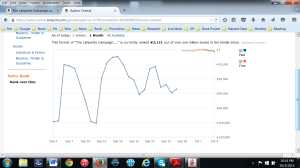 As you can see, the effect of the immediate bump of sales kept the book at a respectable ranking for a number of days – although not high enough to be listed on any charts that might help attract notice. And as of October 7, its rank has already dropped to 16,506.
As you can see, the effect of the immediate bump of sales kept the book at a respectable ranking for a number of days – although not high enough to be listed on any charts that might help attract notice. And as of October 7, its rank has already dropped to 16,506.
By its nature, it’s not yet possible to tell how well I did with respect to my second goal of getting enough books into the hands of readers to start a domino effect.
Trail Costs and Income
On the cost side, I should start by noting that the prices that promotion services charge vary widely. And while the quality of the service is generally reflected in the price, this is not always true. EReader News Today may, by many reports, be the second most effective service out there, but they are also one of the least expensive. You will also learn that many of the services offer multiple levels of service, at prices that may range from a low to several times that amount. For example, during an earlier discount sale, I used a Books Butterfly package that cost $50, but for the free promotion I used a package that reached many more readers, but at double the price.
In my case, I decided to make this a serious experiment, and pay for some of the higher end services to learn once and for all whether there is a reason to ever want to use a free promotion again. Why? Because you can only run easily scheduled free promotions for books listed at Amazon if you are in the Kindle Select program, which requires giving Amazon the exclusive right to sell your eBook title for 90 days at a time.
While it’s true that 90% or more of your sales are likely to come through Amazon even if you’re listed everywhere else, it’s also true that doing so may make it harder to get listed at the top promotion sites, like BookBub, which prefers to promote books that are also available at Barnes & Noble, iTunes, Google, Kobo and so on. So there’s a tradeoff to be made if you want to run free promotions. The only other way to get Amazon to price your book to $0.00 is to set it at that price elsewhere, and then badger the retail giant to price-match. That’s fine, if you want to set a book to permafree, but pretty laborious if you only want to drop your price for a couple of days every few months.
With that by way of prelude, here are the specific services I used for my two day free promotion, and the prices they charged:
Books Butterfly Diamond Package $100
BookSends Book of the Day 125
EReader News Today General Free Listing 25
Free Booksy General Free Listing 100
Total: $350
Books sold at $0.99 as a result of free promotion: 159
Royalty on direct sale results (35% royalty): 56*
Net cost (to date) of promotion: $294
*This would have been $333 if I had reset the price to $2.99 and sold the same number of books. However, I assumed the number of sales would have been lower, and opted to go for more sales rather than more cost recovery.
Clearly, if one were to look at short-term economic returns, running a free campaign using top level promotional services may not be a good return on investment. On the other hand, if a pick up in sales of your book, priced at $2.99 and bearing a 70% royalty results, it could be. At that royalty rate, it would take a total of 140 additional sales to offset the remaining cost of the promotion, and fewer if the free promotion bumps up the number of Kindle Unlimited members that download the book and actually read it as well. Since the first three paragraphs of my first book appear at the end of the free download, I can hope for some additional sales of that one as well.
140 books is not a small number of sales for a self-published book, but it’s also not an impossible one. And if you value your time, and also take into account how few ways an author has to move the needle on sales, you may decide that placing a few hundred dollars on a free download bet may be a wager you’re inclined to make.
Conclusions and Lessons Learned
On my first goal, the results seem to indicate that it would be necessary to either succeed in getting BookBub to take your book, to run more promotions per day, or to run your promotions for the full five day period that Amazon allows. Any of these strategies has the potential to take your book to the number one free spot.
There are three inherent problems with this goal, however. The first is that you need to get enough positive reviews for your book before the best promotional services will accept your book. The second is that it’s difficult to get the day you want with the popular services. As a result, lining up a well coordinated series of promotions requires scheduling them six weeks or more in advance.
The third is that no matter how well your book does on the free list, it will vanish once it returns to paid. So the best that you can hope for is a few days in reader’s headlights. If you’ve used up all five days doing so, it will be 90 days before you can do so again.
The moral of the story therefore appears that succeeding on goal one requires not only careful preparation, planning and execution, but a good deal of luck as well.
As to goal two, I’ll need to collect further data before I can report back on whether a trial of this scale, duration and impact had the desired effect. The real test will be whether a week from now my base line of sales and page reads steps up from the base line before the sale.
So how wise a wager is a paid promotion? I don’t know yet. But when I find out, I’ll let you know. And if you’d like to better calibrate the quality of the data being used to perform this test, you can assess the merits of the book involved by reading the copy you can buy here. 21 reviewers at Amazon so far have assigned it a composite rating of 4.9.

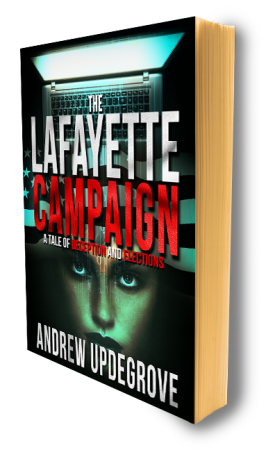
Glad you put the costs and return and potential future exposure/sales.
Regarding, “the real test will be whether a week from now my base line of sales and page reads steps up from the base line before the sale (I’ll post again on this topic a couple of weeks from now to report whether this has, or has not happened).” – looking fwd to it, Andy, thanks!
Thanks, Adan. I just updated this post with a fair amount of additional data, so you may want to take another look at the second half.
Will do, thanks for the heads up 🙂
Thank you for publicising your efforts / results on this relevant topic Andy. My tactic will remain the same I feel, which is to concentrate on working on more than one project, so that I have something appearing every three / four months.
I cut out all the other places and only use the Amazon network, but it’s working. I use my five days in a two-day session and then about a month later a three-day session.
Great info you’ve shared and we can see yiou’ve done your homework.
My pleasure, Tom. And to be sure, there is (thank goodness) more than one way to promote a book. For those who don’t have the time or knack to keep up your rate of production, though, I suspect that discount (not free) promotions through the right services can play a helpful role.
My goal at the end of this process of experimentation will be to suggest an actual launch campaign that an author could try for her new book – names of services, frequency of promotions, and so on.
Wonderful effort great to see such care and attention to detail but even more your opened and sharing attitude.. Thank you Andy
My pleasure. The more we all share, the better we all do.
Well, if my head wasn’t stuck in the sand, it’d be spinning. All I can say is thank you for sharing and that I look forward to seeing what you come up with in your next phase …
My promotional efforts and expertise run from haphazard to non-existent, so I’m afraid I can’t really offer any insightful comments.
Thank you for sharing your promotional experiences. It gives all us Indie writers something to think about regarding our own future promotions.
Thanks very much. Stay tuned; there’s more to come.
I will. 🙂
Thanks for sharing your experiences. I’ve more or less had the same results, but I’m seeing KU and sales rumble on for about 10 days. The strategy I’m trying is something every 15 days with a book from the 2 book series. One thing I have learned is that without paid advertising, nothing happens.
Thanks for insights, Angela, and I’ll hope to see some of that rumbling myself. Have you tried other types of advertising as well? I haven’t heard many authors report any success on ads at (for example) Facebook, and the ads I’ve run at GoodReads have had no results, either.
Another fascinating post, Andrew, and shared with such typical generosity. And so refreshing to see some hard data to balance the spin and hearsay on which self-publishing strategies are so often based. Yet again, heartfelt thanks.
As always, Marcus, you are too kind (but thanks).
Interesting post (I came here via ThePassiveVoice.com, btw). One note: in the fourth paragraph after “Trial Methodology and Near-Term Results”, you give 1% of 4,360 readers as 436 – but that’s 10%. Your hopeful new readership would actually be about forty-four people.
Still, that’s about the same number I’ve had all year total, so please enjoy your last laugh! The one percent of my audience who gets as far as actually reading my stuff is, apparently, only half a person…
Andrew,
Ouch! I hate it when I do that, but thanks for pointing that out so I could correct it.
While I’m not a fan (as I expected) of free promotions, discount promotions can produce results. There are many that reliably produce 20 – 25 sales for $20, and some much more. I’ll be continuing and reporting on my experience with these services, so you might want to give one or two of those a try if you’re unhappy with your sales to date.
Thank you so much for being willing to share these numbers so openly. As an indie author looking to boost her sales, I find it refreshing that someone would offer so many details on what works and what doesn’t. I look forward to hearing about the second half of your experiment.
My pleasure – it’s how we all learn. My only regret is that there isn’t an efficient way for writers to pool their experience i promotion and other areas for mutual benefit.
From time to time I’ve thought about starting sort of a “writers’ coop” site that could support aggregating information, allow book production teams to form (editors, book designers, etc.; there is a site already that does this, but it’s run as a business rather than by those directly involved).
I fully agree that a site like that would be incredibly beneficial to those of us wanting to learn from one another and share our successes and failures. If you ever decide to set up such a site, I’d love to contribute in some way. I could understand the reasoning for running such a site as a business, but I also agree that it should have a “writers first” philosophy.
Andy, Chris Randolph has been mooting a similar idea. I don’t know if he’s still enthusiastic about it, but I’ll give you his info.
https://oktopods.wordpress.com/about/
spectre.7@gmail.com
Jim
Thanks very much for the tip, Jim. I’ll check it out.
As I was just telling Andrew, I’ve compiled data from over 100 authors who have advertised. You can find the results on http://nicholasrossis.me/2015/06/12/call-to-arms-book-marketing-results/
I thought that I had written a detailed description of what such an organization could be like, but can’t find it, so I guess I never got around to it. I’ll add that to me “to do” list and hope to provide a fuller expression of what such an organization might be like.
Thank you for sharing your results! I wish more people did that.
I’ve written some similar posts, and have run a “Call to Arms” survey asking for data in relation to paid promos. You might be interested to have a look at the results, on http://nicholasrossis.me/2015/06/12/call-to-arms-book-marketing-results/
For my latest promos, I went all free; that is to say, I only used free promoters. I had some 800 downloads. You can find the details and a list (on Excel) of said promoters on http://nicholasrossis.me/2015/10/09/promo-results-using-free-promo-services/
Nicholas, thanks very much indeed for dropping by and sharing your links – I feel like a kid in a candy store reading the linked posts, and am looking forward to printing out and studying all of the material that you’ve compiled. This is indeed a treasure trove of data!
I’m particularly grateful as I’m the next step in my experimentation will be to design and run a sustained promotional campaign for my first book, which I haven’t promoted yet by this means. My thought is to try “saturation bombing” with discount sales for a month to see whether it’s possible to raise the profile of a well-reviewed book to the point where it stands a chance to take off. Having the data on these additional services (many of which I didn’t know about) will be a big help in doing so.
I’d also like to join you in giving a shout out for Abhishek Singh (Abhi) at Books Butterfly, who you mention in your post. Abhi has been hugely generous with his time and recommendations to me (even including recommendations to some of his competitors for additional promotions). It was a delightful surprise to find someone like him in the course of exploring the promotional scene.
Yay! I feel the same way about you and your blog, and I’m grateful to the Passive Guy for the tip – that’s where I saw the link here. It sounds like we share the same outlook towards sharing data and book marketing 🙂
If you have the time to add your experience to the survey (http://nicholasrossis.me/2015/03/02/take-the-3-question-ad-results-survey/), that would be great. I’d also love to hear about the results of your marketing campaign. Be sure to check Jackie Weger’s blog for some great info on good and bad promoters (http://nicholasrossis.me/2015/06/24/call-to-arms-jackie-wegers-take/).
Lastly, you can find links to my best marketing data on http://nicholasrossis.me/guides/
So good to hear that we have a similar experience with Abhi. His approach is such a breath of fresh air 🙂
Thanks for the additional links, and yes, I’ll certainly fill out the survey. I’ve also pointed a writers’ group I’m part of to it and suggested to the members that they do so as well.
That is so kind of you; thank you!!
My pleasure, Nicholas. Within a month or so I’ll post the results of my efforts with various promotional services, giving names of providers, costs, and results.